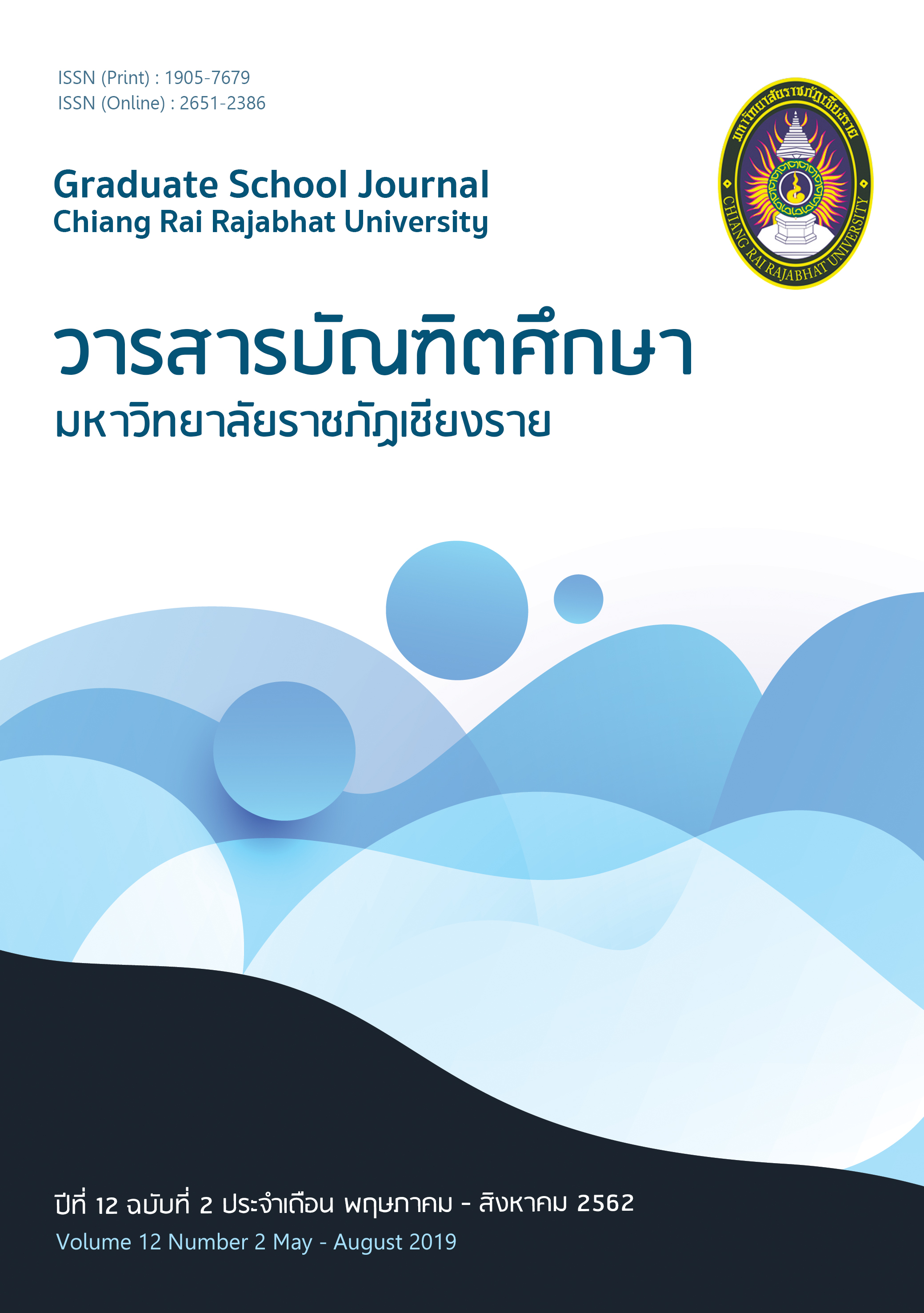THE DEVELOPMENT OF PROBLEM SOLVING AND MATHEMATICAL REASONING ABILITIES ON THE TOPIC OF APPLICATION OF PRATHOMSUKSA 6 STUDENTS USING DAPIC PROBLEM SOLVING PROCESS WITH BADHAM’S QUESTIONING TECHNIQUES
Main Article Content
Abstract
The objectives of this research were 1) to compare the mathematical problem solving ability on the topic of application between before and after learning by using DAPIC Problem Solving Process with Badham’s Questioning Techniques, 2) to compare the mathematical problem solving ability on the topic of application after learning by using DAPIC Problem Solving Process with Badham’s Questioning Techniques at the 60 percent of criterion, 3) to compare the reasoning mathematical ability on the topic of application between before and after learning by using DAPIC Problem Solving Process with Badham’s Questioning Techniques, and 4) to compare the reasoning mathematical ability on the topic of application after learning by using DAPIC Problem Solving Process with Badham’s Questioning Techniques at the 60 percent of criterion.
The sample was a classroom which consisting of 20 students. They were studied in Prathomsuksa 6 in the second semester of the academic year 2018, at Ban Konmuang School, in the area No. 6 of Nakhon Ratchasima Primary Education Service Area., The sample was derived by purposively random sampling technique. The research instruments were 1) the learning organization plan of the application using DAPIC Problem Solving Process with Badham’s Questioning Techniques which consisting of 9 plans, each plan used 60 minutes per periods, 2) the instrument for collecting data was the essay test of mathematical problem solving and reasoning mathematical abilities which, consisting of 9 items. The collected data were analyzed using the percentage, the arithmetic means, the standard deviation, and the t-test statistics. The results were as follows; 1) the mathematical problem solving ability on the topic of application of students, after learning by using DAPIC Problem Solving Process with Badham’s Questioning Techniques, is higher than before learning with the statistical significant at the .05 level, 2) the mathematical problem solving ability on the topic of application of students, after learning by using DAPIC Problem Solving Process with Badham’s Questioning Techniques is higher than with the 60 percent of criterion, statistical significant at the .05 level, 3) the reasoning mathematical ability on the topic of application of students, after learning by using DAPIC Problem Solving Process with Badham’s Questioning Techniques, is higher than before learning with the statistical significant at the .05 level, and 4) the reasoning mathematical ability on the topic of application of students, after learning by using DAPIC Problem Solving Process with Badham’s Questioning Techniques is higher than with the 60 percent of criterion, statistical significant at the .05 level.
Article Details
บทความที่ได้รับการตีพิมพ์เป็นลิขสิทธิ์ของวารสารมหาวิทยาลัยราชภัฎเชียงราย
ข้อความที่ปรากฏในบทความแต่ละเรื่องในวารสารวิชาการเล่มนี้เป็นความคิดเห็นส่วนตัวของผู้เขียนแต่ละท่านไม่เกี่ยวข้องกับมหาวิทยาลัยราชภัฎเชียงราย และคณาจารย์ท่านอื่นๆในมหาวิทยาลัยฯ แต่อย่างใด ความรับผิดชอบองค์ประกอบทั้งหมดของบทความแต่ละเรื่องเป็นของผู้เขียนแต่ละท่าน หากมีความผิดพลาดใดๆ ผู้เขียนแต่ละท่านจะรับผิดชอบบทความของตนเองแต่ผู้เดียว
References
ชุติมา ฉุนอิ่ม. (2558). การพัฒนาการคิดเชิงคณิตศาสตร์ของนักเรียนชั้นมัธยมศึกษาปีที่ 1 โดยใช้ กิจกรรมการเรียนรู้แบบการสอนแนะให้รู้คิด (CGI) ร่วมกับเทคนิคการใช้คำถามของบาดแฮม (Badham). (วิทยานิพนธ์การศึกษามหาบัณฑิต). มหาวิทยาลัยนเรศวร. พิษณุโลก.
ฐิติมา พูลเกษม. (2560). ผลการจัดกิจกรรมการเรียนรู้ตามแนวคิด DAPIC ที่มีต่อความสามารถ ในการแก้ปัญหาและการสื่อสารทางคณิตศาสตร์ เรื่อง การประยุกต์ของสมการเชิงเส้นตัวแปร เดียวของนักเรียน ชั้นมัธยมศึกษาปีที่ 2. (วิทยานิพนธ์การศึกษามหาบัณฑิต). มหาวิทยาลัยนเรศวร. พิษณุโลก.
โรงเรียนบ้านคอนเมือง. (2561). รายงานประจำปีของสถานศึกษา ประจำปีการศึกษา 2560. นครราชสีมา: โรงเรียนฯ.
ล้วน สายยศ และ อังคณา สายยศ. (2539). เทคนิคการวัดผลการเรียนรู้. กรุงเทพฯ: สุวีริยาสาส์น.
วรกมล บุญรักษา. (2561). การจัดกิจกรรมการเรียนรู้แบบร่วมมือเทคนิคการแบ่งกลุ่มผลสัมฤทธิ์ (STAD) ร่วมกับแนวคิด DAPIC ที่มีต่อความสามารถในการแก้ปัญหาและผลสัมฤทธิ์ทางการเรียนคณิตศาสตร์ เรื่อง ทฤษฎีบทพีทาโกรัสสำหรับนักเรียนชั้นมัธยมศึกษาปีที่ 2. (วิทยานิพนธ์การศึกษามหาบัณฑิต). มหาวิทยาลัยบูรพา. ชลบุรี.
สถาบันส่งเสริมการสอนวิทยาศาสตร์และเทคโนโลยี. (2550). คู่มือครูและมาตรฐานการเรียนรู้ กลุ่มสาระคณิตศาสตร์. กรุงเทพฯ: สถาบันฯ.
สถาบันส่งเสริมการสอนวิทยาศาสตร์และเทคโนโลยี. (2551). ทักษะ/กระบวนการทางคณิตศาสตร์. กรุงเทพฯ: สถาบันฯ.
สถาบันส่งเสริมการสอนวิทยาศาสตร์และเทคโนโลยี. (2555ก). การวัดผลประเมินผลคณิตศาสตร์.
กรุงเทพฯ: สถาบันฯ.
สถาบันส่งเสริมการสอนวิทยาศาสตร์และเทคโนโลยี. (2555ข). ครูคณิตศาสตร์มืออาชีพเส้นทางสู่ ความสำเร็จ. กรุงเทพฯ: สถาบันฯ.
สถาบันส่งเสริมการสอนวิทยาศาสตร์และเทคโนโลยี. (2555ค). ทักษะและกระบวนการทางคณิตศาสตร์. (พิมพ์ครั้งที่ 3). กรุงเทพฯ: สถาบันฯ.
สิริพร ทิพย์คง. (2544). ศิลปะการตั้งคําถามในวิชาคณิตศาสตร์. วารสารคณิตศาสตร์, 44(506-508), 16-19.
Cronbach, L. J. (1990). Essentials of phychology testing. (5th ed). New York: Harper Collins.
Hambleton, R. K., et al. (1978). Criterion-referenced testing and measurement : A review of technical issues and development. Review of Education Research, 48(1), 1-47.
Meier S, L., Hovde R. L. and Meier, R. L. (1996). Problem solving : Teachers 9 perceptions, content area, models, and interdisciplinary connections. School Science and Mathematics, 96(5), 230-237.
Way, J. (2008). Using questioning to stimulate mathematical thinking. Australian Primary Mathematics Classroom, 13(3), 22-27.

